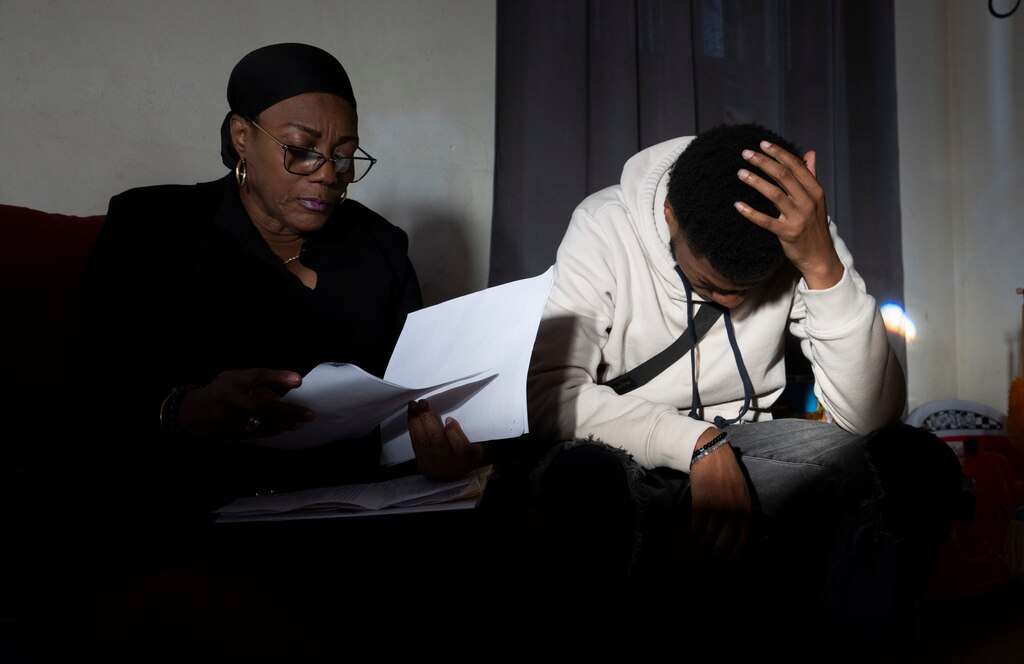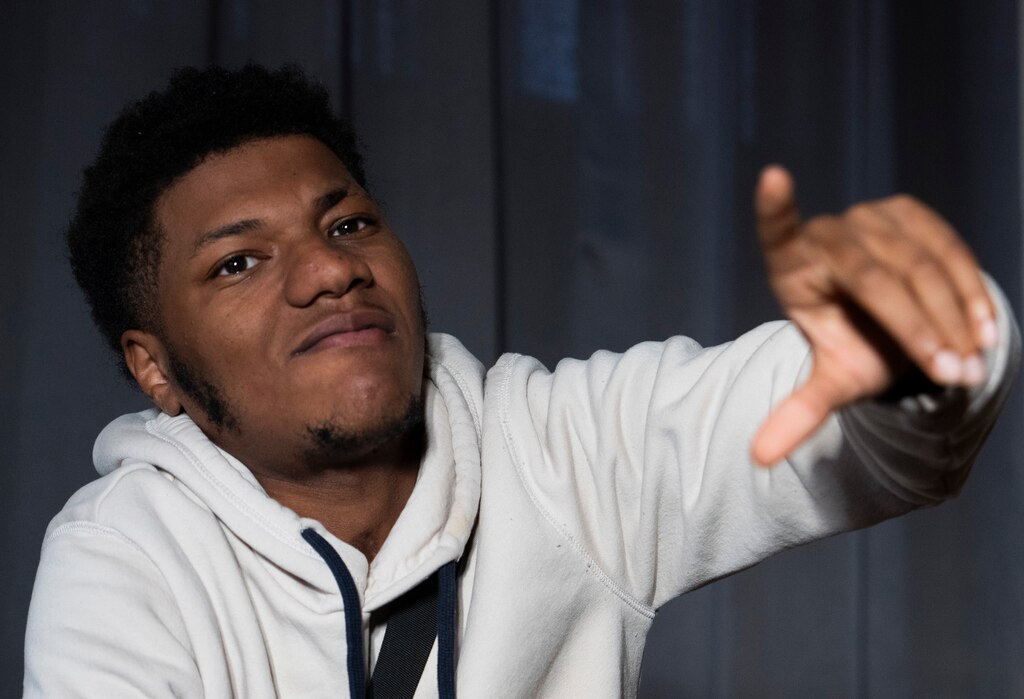The bullet in Maurtice Brown’s brain has lived there for more than nine months. It entered his head the night of April 1, a Saturday, when he should have been safe in the company of two of his closest friends, Connor and Jit, in the finished basement of his home in Glen Burnie.
The three of them were the Musketeers. They spent the day together at a nearby mall. At 17, Maurtice was the oldest.
“I ain’t going to lie,” Maurtice said, “me and Jit tried to take a pair of glasses and got caught by a lady, and we had to get out of that store, and we got stranded. We called [a friend] Tank. His girlfriend picked us up. We came home.”
That is the last good thing Maurtice remembers.
His next memory is of waking up in the hospital, his head wrapped in bandages and tubes. It was days later, in Maryland Shock Trauma Center, although he had no sense of where he was or how much time had passed. “Oh my God, what happened?” he remembers thinking.
For a few days, his family wasn’t sure he would survive. The bullet tore through his nostril and shattered the left side of his skull before settling in the upper part of his head where it remains.
Maurtice still forgets to do ordinary, everyday things, so people need to remind him. He forgets what someone just said, or what he was doing a minute before. He weathers frequent bouts of paranoia and anxiety. He lost hearing in one ear and vision in one eye. Part of his face is numb. He’s prone to seizures. The injury has made his speech slurred. And he lost friendships, no longer trusting anyone associated with his former circle of pals.
But he survived and that makes him lucky. Nationally, the rate of homicide committed with guns almost doubled from 2014 to 2021 for people ages 15 to 19, as firearm-related deaths became the leading cause of death for those under 20, according to data from the Centers for Disease Control and Prevention, when it surpassed car crashes. The trend is particularly sharp in Baltimore, where high school-aged teens made up a disproportionate share of gun violence victims in 2023.
On Wednesday, for the first time since April 1, Maurtice will see Connor, the boy accused of shooting him. He, his mother Margaret Neal, and his older sister Brittany Neal, have been summoned to testify at the Anne Arundel County Courthouse on Church Circle.
Connor has been charged as a juvenile. His last name is being withheld and the charging documents, details of the investigation, and the court proceedings are confidential.
At first, Connor claimed Maurtice shot himself. Later, he admitted to police that he shot Maurtice, but insisted it was an accident. He told police he disposed of the homemade gun in the woods, although police believe he gave it to someone. Connor has spent the months since the shooting under house arrest. This is all according to Maurtice’s mother.
The gun was a ghost gun, Maurtice said. Another friend of his made it. To this day, the gun has not been found.

Maurtice’s mother considered Connor practically a member of the family. He was often over at her house and sometimes spent the night.
“Maurtice is a very caring, very loving kid,” Neal said. “He used to bring everyone in the neighborhood home. He wanted to feed everyone, take care of everyone. He wanted them to move into our house. Now, he doesn’t trust anyone. He’s always thinking something is going to happen.”
Maurtice is the youngest of her six children. Brittany, 25, is her second youngest. Maurtice, Brittany and Brittany’s five children live with Neal, who was out at a function when her son was shot. Brittany and her kids were home. She remembers hearing one loud bang coming from the basement. She rushed downstairs, passing one of Maurtice’s friends on the stairs — she doesn’t remember which one. She found her brother bleeding on a bed. Another friend tried to call 911 and clumsily administered CPR.

Maurtice was born in Philadelphia but grew up in Baltimore. When he was 13, Neal moved to Glen Burnie “to keep him from the gunfire,” she said, into a seemingly tranquil neighborhood of older ramblers and split-level homes.
“I’m angry that it happened because it took a lot away,” Neal said. “I’m pissed that it was Connor. He was my boy. Never in my wildest dreams, of all the kids, could I imagine he could be responsible for something like this.”
She is looking forward to seeing him court, to looking him in the eye. She wants to know, “What is this going to be?”
He sent her a message shortly after the shooting, one that she does not believe he wrote himself.
“Hey Miss Margaret. I’m so very sorry. Words can’t even explain how sorry I am, hurt to the bottom of my soul. I understand if y’all don’t ever want to see me again. But know Maurtice is one of my greatest friends ever and I’m praying to God that he pulls through. I need him to know I love him. This was not intentional. I know words will never make up for this but I truly do apologize.”

A few weeks later, he sent her another message:
“I know you must think the worst of me … but I promise you on everything I love that I would never intentionally hurt your son … I need you to see the truth and know how I feel and how much I’m hurting from this. Knowing that I put my best friend in the hospital is killing me so much.”
The messages didn’t do much to sway Neal at the time.
“It didn’t matter to me,” she said — not while her son was fighting for his life.
In the months since, the shooting has continued to dumbfound her. She has heard rumors of what it might have really been about, a gang initiation, a mean stunt, or a mindless teen dare gone wrong.
The shooting has left Maurtice emotionally disoriented, unsure of how to interpret the world and people around him, so he avoids both. He has become nocturnal, staying up all night playing video games Fortnite and Gran Turismo. When dawn breaks, he finally goes to bed, sleeping most of the day.
“Sometimes I feel lucky,” Maurtice said, “but sometimes when I’m mad and depressed, I think if I had to come back for life to be like this, why didn’t I just die.”
He rarely leaves his house and stays mostly in his room. He started smoking before he turned 12 and was addicted to nicotine when he was shot. He spent months on a nicotine patch after he was released from the hospital and still fights the urge to vape. The cravings are constant. He has also developed a phantom sensation in his left nostril from a stent that has since been removed, a feeling of “a big booger” that he cannot get rid of, he said. His appetite comes and goes. His jaw remains a little uneven, he said, making it hard to chew.
Brittany is the one who is at home with him most of the time. Neal, 57, works as a caretaker for an elderly woman, and runs a housekeeping business.
“I remind him to brush his teeth, to eat, to wash up,” Brittany said. “His memory is kind of messed up. Basically, I try to lead the way for him. A lot of the Maurtice I know is gone. He just does things differently.”
Come spring, when the lease ends on their house in Glen Burnie, the family will move again, probably to Towson. A new place with new faces.
“I don’t feel safe for him here,” Neal said, “because we didn’t know why this happened. We still don’t know.”




Comments
Welcome to The Banner's subscriber-only commenting community. Please review our community guidelines.